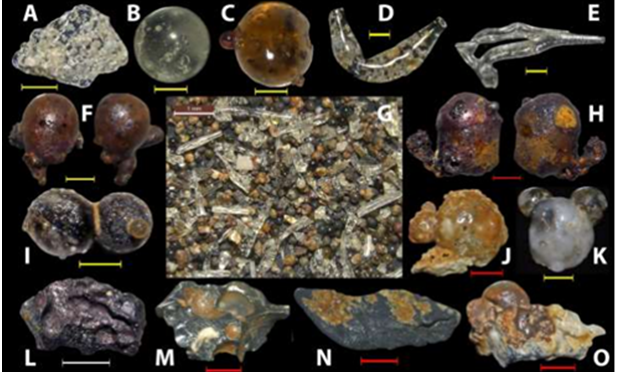On August 6th, 1945, the United States detonated a 5-ton nuclear weapon over Hiroshima, Japan. The result helped end WW2 in the Pacific Arena as Japan surrendered less than one month later, but it was devastating to the city of Hiroshima and its immediate surroundings. Approximately 100,000 Japanese perished in the blast and about 5 square miles of the city were obliterated as ground temperature reached above 1800⁰ C in the firestorm that followed.
Images of the area immediately after the bombing and resulting firestorm indicated that very little of the buildings that had been there remained. But anyone who has taken a science class knows that matter cannot be created or destroyed. So where did the material from all those buildings go? Scientists think they have found the answer. After melting in the original firestorm generated from the blast it refroze as fine particles in the atmosphere and fell along the Japanese coastline. And a team of scientists working with sand from the beaches just a few kilometers away reported finding it just 2 years ago (Wannier et. al., 2019a). In their landmark paper, the authors claim to present the first description of fallout debris from a nuclear explosion in an urban environment

The researchers sieved sands from several Hiroshima area beaches into 7 size fractions from granules to very fine sand. Each size separate was then meticulously inspected. The majority of sand grains were subangular quartz and milky feldspar with subordinate biotite and other mafic grains from the Cretaceous age granite that constitutes the bedrock around Hiroshima. But there also was a significant component of spherical and filament-shaped grains that were clearly not of local geologic origin. These grains, called Motoujina Fallout Debris (MFD) by the researchers, were generally shiny, rounded, and glassy and were easily distinguished from the grains of the host sediment.
Sand grains identified as MFD were meticulously separated from geologically derived sand grains. The authors identified and point counted six different types of MFD based on optical microscopy and chemical composition as determined by SEM/EDA analysis. From a macroscopic sand description, it seems they can be combined into two main groups: spherical globules and filament-shaped glass. Aluminum, silica, and calcium dominated the chemistry of the amorphous glass material, with some also showing appreciable iron content. They also found a mullite-anorthite microcrystal assemblage consistent with formation temperatures exceeding 1800⁰ C (Wannier et. al., 2019a). Mullite is a rare aluminum silicate mineral (3Al2O3·2SiO2) that has a melting temperature of 1840⁰C.

from Wannier, et. al., 2019b
How abundant were MFD in the Hiroshima beach sand? The coarse sand fraction contained the highest percentage of MFD as ~2.5% of the grains counted from coarse sand were identified as fallout debris. By comparison only 1.6% of grains in the fine-grained sand size fraction were logged as MFD. Even more interesting was the variation in the morphology of the grains of fallout debris.

I wonder how many arenophiles have samples of sand from the beaches near Hiroshima? And for those who do, I wonder if anyone has looked for Motoujina Fallout Debris?
Similar “fallout” spherical sand grains have been documented adjacent to meteorite impacts where melted (or shocked) rocks have been thrown great distances, such as tektites and impact glasses. However, to the best knowledge of the authors of these papers, the MFD found near Hiroshima record the first documented example of anthropogenic fallout from the detonation of a nuclear blast.
References:
Wannier, M.M.A, de Urreiztieta, M., Wenk, H-R., Stan, C.V., and Tamura, N., 2019a, Fallout melt debris and aerodynamically-shaped glasses in beach sand of Hiroshima Bay, Japan, in Anthropocene, vol. 25, March 2019
Wannier, M.M.A, de Urreiztieta, M., Wenk, H-R., and Tamura, N., 2019b, Fallout debris from the Hiroshima atomic cloud of August 6, 2021, Abstract: Goldschmidt Conference of 2019
Wikipedia entries on Hiroshima
